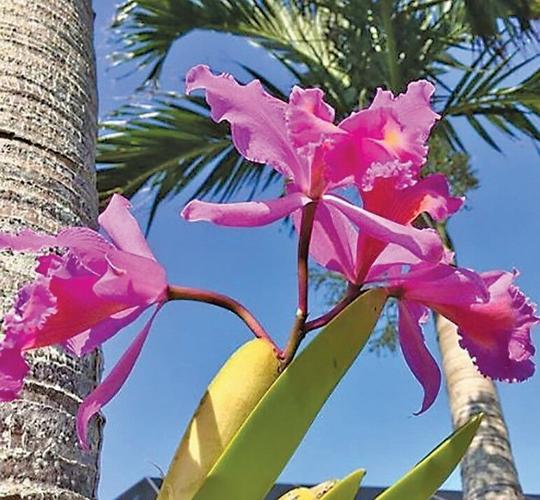Most orchid hobbyists grow their orchids in pots, but for this article the author is sharing her experience successfully growing Cattleya (Kat-lee-ah) orchids outdoors attached to palm tree trunks and sturdy branches of small trees in her backyard.
Cattleya orchids used to be called the Queen of Orchids for their showy blooms and were the Prom Queen’s favorite corsage. The Cattleya is still very popular and will always be an impressive addition to any orchid collection.
Cattleyas have been widely hybridized, making them available in a wide spectrum of amazing colors, except blue. Some come with freckles, two tones, streaks and some are quite fragrant. Cattleyas are easy to grow, which makes them ideal for the beginner orchid hobbyist. Cattleyas are epiphytes (air dwellers) and have evolved, growing best on a tree trunk in the upper story of a tropical rain forest. Most orchids, including the Cattleyas, were bred to live comfortably in this wild setting. If you have a Cattleya, do it a favor and tie it onto a tree trunk and watch it bloom. They do not need any extra medium like moss to grow, as the roots will eventually attach themselves to the tree trunk or limb. Almost all of the palms in my backyard have Cattleyas covering their middle/ upper trunks. Palms, coconuts and fruit trees make fantastic orchid hosts. Palms are tall with plenty of bare trunk and the leaves throw a balance mix of light and shade for the Cattleyas. Cattleyas need bright light but should be protected from direct midday sun. If the leaves are rich green, it is not getting enough light; if the leaves are light yellow-green, it’s getting too much light. If the leaves are medium green – this is the healthy shade needed to bloom.
I usually wind the fishing line around the orchid making sure orchid is tightly attached to the trunk and does not move. Fishing lines are invisible, strong, and in about a year or two will wear out and fall apart. By then, your Cattleyas will be firmly anchored to the tree by its own roots. Water does not accumulate at the roots, so there are fewer chances of root rot.
For best results make sure the water sprinkler heads are positioned to give them a spray at least twice a week. Cattleyas need periods of dryness between watering, so don’t over water.
Though not heavy feeders, Cattleyas can benefit from an occasional boost of very diluted MiracleGro. When in doubt, it is best to err on the side of too little than too much. Happy orchids give forth beautiful flowers once or even twice a year.
Enjoy your Cattleyas in the wild!
For more information on Calusa Garden Club and its February program, please visit www.calusa.org.





Post a comment as Guest
Report
Watch this discussion.
(0) comments
Welcome to the discussion.
Log In
Keep it Clean. Please avoid obscene, vulgar, lewd, racist or sexually-oriented language.
PLEASE TURN OFF YOUR CAPS LOCK.
Don't Threaten. Threats of harming another person will not be tolerated.
Be Truthful. Don't knowingly lie about anyone or anything.
Be Nice. No racism, sexism or any sort of -ism that is degrading to another person.
Be Proactive. Use the 'Report' link on each comment to let us know of abusive posts.
Share with Us. We'd love to hear eyewitness accounts, the history behind an article.